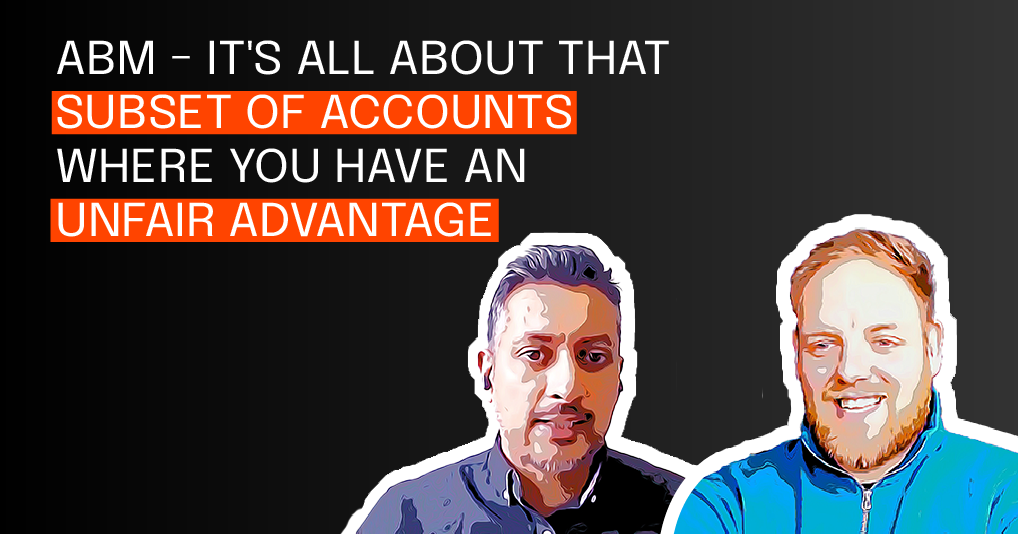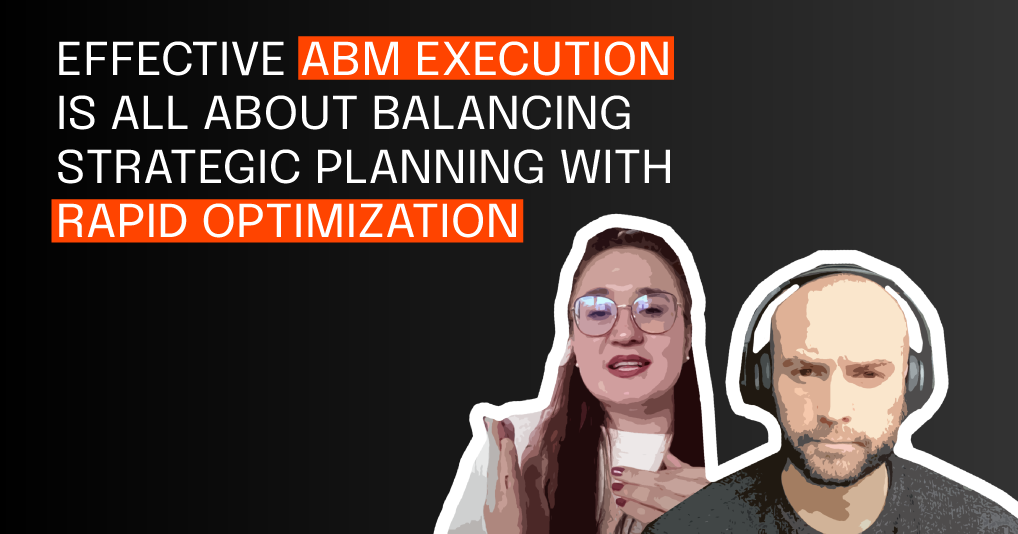Do you know your Total Addressable Market?
8 August 2024
Jack Rawlings & Josh Weale ▪︎ Heads of ABM
How do you establish your total addressable market (TAM) in ABM? From defining and refining, to aligning across the business, Jack and Josh explore how to set your program up for success.


Josh is a Head of ABM, leading the development of innovative strategies to help enterprise tech businesses win, grow and retain their most important accounts. With a background in journalism and several years of client-side experience, he works with Sales and Marketing teams to help them succeed.
ABM Lunch and Learn
Fast forward your team's ABM learning and accelerate your growth
We’re on a mission to create great ABMers
Subscribe to our ABM insights and podcast releases.
Why TAM Is Vital in ABM
What do we mean by total addressable market (TAM) in the context of ABM?
For many ABM’ers, TAM might be an area that’s not as considered. After all, the goal with ABM can be to move beyond TAM and into a more specific focus. However, getting TAM right sets the parameters for ABM program success.
With this in mind, Jack and Josh explore the considerations, challenges and points to think about when establishing your total addressable market in ABM; from defining to aligning your focus across sales and marketing.
Read Podcast Transcript
Jack Rawlings (strategicabm) - Welcome back to another episode of ABM Under the Hood. My name is Jack Rawlings. I'm joined again by my colleague, Josh. Hi, Josh.
Josh Weale (strategicabm) - Hey, Jack. Good to be here.
Jack (strategicabm) - Good stuff. So, this week we're going to be talking about specifically the total addressable market, which is a, kind of, I suppose, maybe somewhat overlooked subject when it comes to ABM because obviously, you know, the kind of goal really with an ABM program is to sort of get beyond that stage of focusing on your total addressable market. But there's a lot of elements within that, that is kind of really important to understand and be clear about, I guess, when you're setting up a program.
So I guess to start with, Josh, if we can kind of just dig into maybe just defining what we mean by total addressable market in the context of ABM.
 Josh (strategicabm) - Sure. Yeah. I mean, from when you're first setting up your ABM program, you're generally, you're coming from a place where you've been doing B2B marketing for a while. You may be kind of mid-market or you may be selling into enterprise already, but typically you've been doing kind of B2B lead generation, demand generation. And what you're finding is that you've got kind of more complex and longer sales cycles that you realize that you need a, different go-to-market for these types of accounts.
Josh (strategicabm) - Sure. Yeah. I mean, from when you're first setting up your ABM program, you're generally, you're coming from a place where you've been doing B2B marketing for a while. You may be kind of mid-market or you may be selling into enterprise already, but typically you've been doing kind of B2B lead generation, demand generation. And what you're finding is that you've got kind of more complex and longer sales cycles that you realize that you need a, different go-to-market for these types of accounts.
What Is a Total Addressable Market (TAM)
So typically, what we mean when we talk about total addressable market in the context of that kind of need to switch to an ABM mindset is thinking about the, your overall market in terms of who you could sell to in terms of the product-market fit, who could buy your solution over the time period that you're looking to sell it.
And then really defining that at a, kind of, a scale of what makes sense in terms of setting parameters of this is our total addressable market for kind of everybody that could afford our solution, everybody that's interested in our solution. And then from there, working out what are the parameters to narrow in? But ultimately total addressable market is kind of anyone you could sell to that fits your product market needs.
Jack (strategicabm) - Yeah, I think that's a good, yeah, that's a good definition, a good starting point as well. And so, I guess from a perspective of kind of progressing with an ABM program, what do you, what do you think is the benefit of really sort of understanding or being clear about your total addressable market? What, what do you think it allows businesses, ABM teams to do if they, if they kind of have that clear picture of potential total addressable market?
Josh (strategicabm) - I think, ultimately, it sets the parameters for the whole ABM program. It gives you a starting point to work from. By having that clearly defined, you know what the potential opportunity is within that total addressable market. And it gives you direction on where to focus your efforts, because if you know that you've got a certain objective revenue number that you need to hit, it gives you a view of kind of what's our broadest opportunity and then what are the accounts within that opportunity that we need to focus on to be able to hit that revenue number. So I think it's about kind of setting the baseline for the ABM program.
Jack (strategicabm) - Yeah, yeah, that makes sense. Yeah, and I guess it's also kind of like, it's I suppose as much about excluding types of accounts as well, right? So, so, you know, the whole point of ABM is to get to the point of being able to narrow down your focus as far as possible, you know, within a kind of reasonable framework.
And if you are able to already off the bat kind of discount certain businesses that you could in theory target, but for whatever reason actually in practical terms are not a right fit for you, then that kind of helps, you know, just narrow down that kind of, that yeah, that sort of lens or frame that you might be kind of going after. And I guess when you're talking about what could be thousands of accounts, the, whatever you can do to kind of give yourself a bit of a headstart, getting that narrowed down is going to help, you know, massively, right?
Josh (strategicabm) - Yeah, absolutely. I mean, yeah, as you said, it's as much at all about exclusion as it is about inclusion. What it does is it allows Sales and Marketing to align on kind of who are the accounts that it just doesn't make sense to focus time and effort on.
Because, as we've kind of discussed in previous episodes, ABM is a, ultimately it's a, it's a go-to-market strategy that requires, just by its nature, more resource, more time, more effort. And we all know that we work in businesses where that's not in an unlimited supply. So it helps to really focus the mind on the accounts that make the most sense to go after and exclude the ones that may sometimes kind of just be, they look on paper, they look like they could be a good fit, but are they really worth making that investment? It's about deciding how to make an investment in time and effort with ABM.
Jack (strategicabm) - Yeah. Yeah, absolutely. So, you talked a little bit about kind of approaches to defining your total addressable market, but let's kind of dig into that a little bit deeper. So in terms of sort of potentially accurately identifying your total addressable market or kind of sizing it as well. I guess, as in, you know, is it, is your total addressable market the kind of all of the accounts that you could potentially go after in a specific region? Is that your total addressable market or is it actually larger than that or is it smaller than that? You know, what are the kind of factors that are at play when we're kind of defining that total addressable market?
Josh (strategicabm) - Yeah, I mean it is going to be different for different companies and again, it'll come back to kind of the resources and your ability to service these accounts. So if you've got a Sales team that are only able to kind of service one region, then it probably will just be regionalized.
But ultimately, it's about kind of working with the Sales team to define kind of some baseline parameters that say that we only want to speak to target accounts that meet a certain threshold in terms of they can spend this much money, or they've got revenue potential of X. And understanding kind of what that lowest threshold is. And that will, is ultimately what will give you the kind of broadest, total addressable market.
Tools & Data Sources
Yeah. It is about kind of getting in a room with Sales and working with them on kind of defining what is our kind of lowest baseline in terms of an account's ability to spend with us, an account's fit with us. And then using that as the guide to kind of define, these are our broadest pool of accounts and you can obviously use third-party data tools, things like Apollo or ZoomInfo, to kind of plug that information in.
Building & Validating Your TAM
Firmographic Criteria
Usually you'd use kind of firmographic criteria like annual revenue, company size, employee size, those kinds of criteria to build out a kind of baseline profile of all of the accounts that you could possibly reach. But that ultimately just gives you that figure of, this is everyone we want to reach.
Your next step is to then approach it. And I know we're not necessarily talking about Ideal Customer Profile today, but that would be the next step, is starting to layer on top of that baseline with your Ideal Customer Profile set, which is looking at your existing customers, looking at your kind of existing closed-won deals and understanding, what is it about those closed-won deals and customers that helped you to close that deal in terms of accelerating the sales cycle. If it's a good fit, the type of company you're selling into, their needs, their challenges, what problem did you help them solve?
And really by doing that analysis work on your existing customer set, you're able to start to understand what are some of the more nuanced criteria that you can then overlay into your addressable market to start to narrow it down into your, what we'd call the Ideal Customer Profile. But yeah, ultimately the starting point is that kind of what's the baseline figure in terms of firmographic data that we can sell into based on just pure fit to be able to buy the product or service.

Jack (strategicabm) - Yep. Yeah, that makes sense. Yeah. In terms of kind of time, timeframes, you know, I guess milestones or moments to kind of reassess total addressable market, what would you say, is there a specific kind of say, cadence that people and businesses should look at? Should it be, you know, every six months, every 12 months, or should it instead be based around specific events? Maybe they've got a new product or service that's entering into the market with or something like that. Is, how would you kind of approach the, sort of, yeah, the cadence of updating your total addressable market?
Josh (strategicabm) - Yeah, I think it's a good question and it's really going to depend on your starting point. Ultimately, if it's your kind of first ABM program, your starting point will be to define that total addressable market. And then typically, you want to kind of refresh it over periods of time, periods of quarters, understanding kind of which accounts are in market, which accounts can we reach, are there any new accounts that have recently had funding that now kind of crossover into that threshold that we are now looking at targeting?
So it'll ultimately depend on who you are trying to engage with, what the types of accounts are, and just being able to kind of dynamically view that total addressable market using data points, as I said before, like third-party data platforms that can kind of bring those accounts into it. That's kind of the best practice approach.
Obviously if you don't have access to some of these data points, it's typically kind of just on a quarterly basis review, kind of the market context review, kind of any latest kind of information in the market in terms of industry reports, any big major compelling events that mean there's a shift in kind of how companies are operating or changes in the way that companies are funded, any of that kind of stuff.
Obviously it's going to very much depend on the service and solution you're selling, but all of these things could have an impact on whether an account is a good fit for your total addressable market.
Jack (strategicabm) - So in terms of considerations, challenges, sort of points to think about when a company, business is trying to define their TAM, what are some of these kind of challenges that businesses might face? Is it a case of thinking too broadly or too narrowly? Is it a case of people having different opinions in different teams? What's some of the kind of main challenges, objections we see when it comes to kind of getting that final target, total addressable market kind of confirmed?
Aligning with Sales
Josh (strategicabm) - Yeah, I would say one of the biggest challenges is just misalignment. Misalignment leading to kind of over-exaggeration of the size of the total addressable market. Because ultimately, when you're going into the ABM program, it's, by default it's about Sales and Marketing alignment.
But if Marketing have done the work in terms of defining their total addressable market of we know that we can, there's demand within a group of accounts, maybe like 500 accounts, but then Sales have a view that there's potentially 2000 accounts that they could reach, then it's kind of, how do you find the middle ground of who's actually got the most realistic estimate of that total addressable market?
Because the implications for over-exaggerating the total addressable market is it kind of throws off your entire kind of objective setting process because you can't realistically build any kind of models or frameworks to assess what you need to achieve in your ABM program to hit your pipeline goals or revenue goals if your starting point is overinflated, because ultimately your total addressable market is kind of defined by where is there demand in the market and which accounts can we focus on?
But if you are, if you can actually only focus on a segment of that, because the rest that is kind of an inflated number, you're really starting behind the line before you've even kind of got your program off and running.
Jack (strategicabm) - Yeah, yeah. Absolutely. Yeah, I think, I think it's often the case that the Sales team, it's more, more common, I think, and this is not by any means to paint Sales teams with, you know, all the same brush, but it is more common for Sales teams, I think to potentially overinflate the possible total addressable market because from their perspective, you know, they would rather an account be included than not included I think in most scenarios because there's, if there's a chance of a sale, there's a chance of a conversation then, then from their perspective that's, you know, they'd rather that they sort of erred on the side of caution.
But obviously with, from a Marketing perspective, in terms of kind of driving conversions and, you know, those sort of pre-sales metrics, I think you are always going to want to kind of limit the kind of scope of types of accounts that you can go after and make sure that there is a kind of benchmark baseline of quality or sort of threshold that accounts need to meet in order to kind of get into that list. And I think, otherwise you end up with these kind of, you know, numbers where it's like really low conversion rates or really low kind of moving from one stage of, you know, Reputation to Relationships or whatever.
And actually it's just because you've selected far too many accounts or you've considered far too many accounts in the first instance. And again, yeah, it's not always the case that that's coming from Sales. Sometimes Marketing think that by kind of stuffing the sort of top of the funnel, there might be that kind of, you know, better results on the kind of other end of it. But actually I think, yeah, it tends to be that the Sales teams will want to, you know, do their best to just have as many opportunities to start conversations and book meetings, et cetera, as possible.
Josh (strategicabm) - Yeah. Yeah. I think the other thing to think about in terms of when we're thinking about what's a realistic TAM as well is thinking about how are you actually going to reach these accounts and like lines of service and distribution.
Like if your total addressable market is, there's 200 accounts that you can reach directly, that's your total addressable market, there could be a bigger total addressable market of 500 accounts, but if a percent of those need to be reached indirectly through a channel partner or through different kind of opportunities or go-to-markets, it's important to kind of split that out because otherwise you are then trying to measure every aspect of your ABM program in the same way, despite there being limitations or restrictions on how you can actually talk to those accounts.
Because it will require a different strategy. It might require a longer term play, it might require kind of completely different approach to kind of content and engagement. And obviously, if you are trying to engage with accounts indirectly through partners, you don't always control the entire end-to-end process, as much as, kind of, with a good partner, you can work very closely, you can't control all the kind of narrative and you can't control all of the conversations. So there's always kind of innate risks there.
So it's, yeah. When it comes to kind of being realistic about your TAM as well, you should probably think about kind of how you're actually going to engage with these accounts and whether you can engage them directly or whether it requires a slightly different approach.
Jack (strategicabm) - Absolutely. Yeah. Yeah. And I guess, you know, as always as well, the budgets comes into it, right? It's the amount of, yeah, I think if, a question that sometimes you get from, again, sometimes Salespeople, but it can be anyone in a business really, is can we target all of these accounts or could we consider all of these accounts in our total addressable market?
And the answer is yes, you could in theory, if you've got the budget to support that kind of go-to-market approach, right? If you've got a total addressable market of 10,000 accounts and you are willing to spend what it requires per account to convert into a, you know, meeting or whatever result you're looking for, then yeah, absolutely. If you've got millions and millions of pounds budgets to put into it, then potentially that's doable.
Again, also if you've got the team infrastructure et cetera there to support that. But more likely is the case that you don't have that level of budget, you don't have that level of resource in-house or you know, agency support or whatever, to be able to actually target that many accounts at the level that's required to actually, you know, move the needle or convince them of anything. So it kind of becomes, it becomes a case of prioritization as we kind of always touch on really with ABM, it's down to where should you prioritize your spend, your resources and time.
Okay. One sort of final question I guess on the TAM side of things is around expansion of total addressable markets. So there's a, there's definitely a, there's definitely a kind of time and a place for adding new accounts into your total addressable market, right?
I think it's something we were sort of talking about earlier in terms of when potentially can you bring them in, but what do you think about how new products, new services, new areas of business, entering new markets, all of that kind of stuff, how can that affect the expansion of a total addressable market? Is it something that people should have kind of a process mapped out for or is it something that can be done a little bit more ad hoc? What are your thoughts there?

Josh (strategicabm) - Yeah, I think, I think it's a case of looking at kind of what have you done within your original TAM? Let's say you just focused on a single region, single product, looking at what you've done to kind of assess the size of that TAM and scope it out, and then the relevant ABM campaigns that you've run into it. And just seeing with a kind of close analysis on what's worked, what hasn't, and understanding kind of where can you leverage what you've learned and apply that to another market or another region.
Obviously there's going to be nuances and differences when it comes to actually engaging and executing in those different segments, but in terms of actual expansion, the learnings that you get from that original kind of pilot approach is what you should apply into understanding how can I take this approach and apply it to the next region or the next market.
And in terms of the process for doing that, I would say there's kind of a few key steps and few key considerations and ultimately it's about kind of looking at the criteria that you set in your original, original TAM assessment and saying, does this still make sense in the context of this region based on everything that we know or based on this account set, based on the product that we're trying to sell?
When & How to Revisit Your TAM
And ultimately trying to make a kind of objective view of whether that applies or whether you have to make changes to that. But then, in terms of actually developing that TAM, again, revisiting kind of third-party vendors for data to be able to scope that out based on a criteria set or a data set. And then working from that to identify what is your kind of serviceable market and then going into your ICP from there.
From TAM to ABM: Next Steps
Jack (strategicabm) - Yep. Yeah, that makes sense. Good stuff. Well I think, we'll leave it there for now on total addressable market. We've obviously got a lot more to kind of discuss when it comes to the next steps, which is sort of as you hinted at, you know, developing your ICP, target account lists, and thinking about, you know, that segmentation approach. And I think that's, those are some topics that we're going to kind of touch on in more depth in coming episodes. But for now, thanks very much Josh for your time and yeah, catch up with you soon.
Josh (strategicabm) - Cool. Cheers, Jack.
Key Takeaways & Further Resources
1. TAM sets the stage for your ABM scope and resource allocation.
2. Balance Sales & Marketing inputs to avoid over/underestimating TAM size.
3. Continuously revisit and refine TAM with real market data.
Catch up on all ABM under the Hood episodes here.
Make sure your ABM engine is finely tuned. Subscribe to future episodes.
Let's talk
Looking to start your ABM journey or need help with your current program? We'd love to know more.
Here's a simple form to start the conversation
Alternatively - grab a time here to talk
- Follow strategicabm on X
- Follow strategicabm on LinkedIn
- Follow strategicabm on Facebook
- Follow strategicabm on YouTube
- Follow strategicabm on Instagram
© 2026 strategicabm / Strategic ABM Ltd. All Rights Reserved | Privacy
Strategic ABM Ltd is a private limited company registered in England & Wales. Registration number 13082021.
HubSpot Platinum Partner
Google Certified Partner
Nexus Gold Accredited Partner







